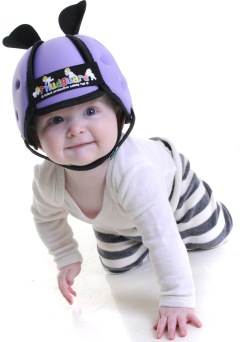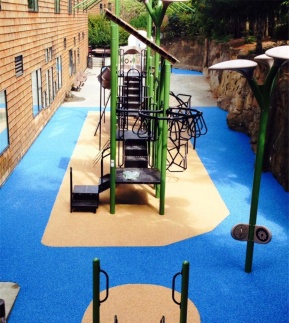This post first appeared at Playground Professions 2-10-15
I recently posted this image of the ThudGuard helmet on the Linkedin Playground Safety: Balancing Play Value & Injury Prevention group and asked what the members thought about it. After the predictable bout of mocking the discussion became quite interesting. There was one mother who thought it was a good idea but the majority felt is was another indication of over-protective parenting. Mind you, this is primarily a group of playground safety advocates, so their take was somewhat surprising.
Since I’ve been involved with designing and marketing play apparatus, fall surfacing, climbing walls and skateparks the issue of protecting kids from falls and the use of helmets has figured prominently throughout my five decades in this field. My experience leads me to the opinion that helmets, and other protective gear should be worn when the player has the intention of testing the limits of their skill or when the environment is unpredictable. For example helmets when dirt biking or on busy streets are a good idea but may not necessary when playing in the neighborhood.
What makes us safe is not protective devices but judgment, honed reflexes, and fundamental movement skills. The goal is to reduce the frequency and severity of injury. If you watch a toddler learning to walk they have several innate behaviors that help achieve this end. When they are about to fall forward their reaction is to resumes their crawling gait and extend their arms in what is called “protective arm reflex.” When the fall is backwards they drop to their bottoms. In both cases these instinctual reactions to the job of head protection very well.
The question arises then, what is the impact of using a safety helmet? In talking with child development physiologists they suggest several issues. First they suspect, although there is little research on this, that such protective gear may disrupt the normal progression of reflex maturation. They also are concerned that the lack of consequences when falling may retard the child’s ability to form proper assessments of their skill, i.e. reduce their judgment. Finally they speculate that it reinforces a pattern of parenting that is over protective and ultimately harmful.
From this example we can see that, what might appear as a good idea is fraught with complexity and perhaps unintended consequences.
Turning to playground safety it will probably be news to you, but the ASTM Playground Surfacing Committee is proposing to significantly increase the resilience requirements for playgrounds. The motivation appears to be that the goal of improving playground safety with the current standard has not significantly reduced the number of hospital visits.
To my mind this is not unlike the logic of the medieval doctor who, when their patient did not get well with one blood letting concluded that they needed more blood letting.
There are many possible reasons for the accident rates to remain unchanged that have nothing to do with the resiliency of the landing surface. One possibility is that the recent trend to cover the entire playground with rubber is so expensive that the amount of play equipment has to be reduced significantly. This results in a lack of events, which in turn reduces the opportunities for graduated challenge that allow kids to gain skills incrementally. On the one hand little kids must use equipment that is beyond their skill level and on the other hand older kids find little to challenge them and so use the equipment in inappropriate ways.
Edge to edge rubber is becoming the norm.
Another possible reason is that playgrounds have become so sanitized of challenge that most kids play elsewhere and the few kids who do come are far less skilled. We may be designing playgrounds for “motor-morons” who have poor reflexes and judgment.
There are also methodical and significant questions about how the data on accidents is collected that make the notion of imposing yet another expensive round of surfacing upgrades based on these “facts” highly suspect.
The point is that we just don’t know the answer.
But we do know the ASTM process, and it is deeply flawed. As you may recall the initial data for the standard was drawn from research on automobile accidents. This makes a certain amount of sense because in the car crash scenario most of the variables are known and controllable. On the playground this is just not possible. Without a complete understanding of the human factors we cannot be confident that any proposed solution will be effective.
I am reminded that the first time I saw an installation of 6-in of loose rubber chips I was astounded to see kids literally throwing themselves off the play structure as if they were jumping into a pool. We do know that kids will often play up to the point of pain. When you pad the pain they just push harder.
It is quite clear that the whole process used in the creation of the surfacing standard is not based on robust science. For example there has never been a formal A/B test where the same equipment and populations used different levels of fall attenuating surfacing. I can say that my experience in those cases where wood fiber was replaced rubber mats the incident of broken arms went from zero to several times a month. This got to be such a known risk factor that in many cases the wood fiber was reinstalled over the mats.
The industry is quite candid in their acceptance of this situation. They know that mats produce more long bone injuries than wood fiber. The notion is that the benefits of mats outweigh that exposure because kids get broken arms all the time and the main concern is head injuries. Well, tell that to the young lady who had a break on her femur grow plate and now has one leg two inches shorter than the other. Ask her how it feels to never be able to wear nice shoes, not to the prom, not to her wedding. The industry’s lack of concern for these sorts of injuries suggests that safety may not be their first priority.
Finally, how can we expect a system, in which every person in the decision-making process has a profound conflict of interest, to arrive at the overall best solution for society? How can we expect a process which is populated exclusively by engineers and business owners, and which systematically excludes broader representation, to understand that not very problem can be solved by the only tool they have.
I say its time we take a pause. It is time we demand that there be a broader range of experience, expertise and opinion brought to bear on the issue. And it is time that we require actual proof that the proposed increase in the standard will actually produce the intended improvements to children’s safety.


Well done Jay, If this is what happens when one get’s older and wiser, I’m looking forward to it.
There is so much thoughtfullness in your posting. I envie you 😉
LikeLike
Hi Jay. I am Portuguese, quite a small country gere children’s play Is not a political interest. Of course we have very serious problems and play Is not considered as one
My research about what children want when they play in lhe playground shows that adults do not much about their needs, When I reed what you write I feel that I’m not alone. Thank you
LikeLike
I agree with your thoughts on playground safety. I installed playground equipment and safety surface for 10 years and development a safety surface made from recycled waste plastics. It acts like rubber but it is plastic which does not create dust or get as hot as other safety surfaces. I have a little more information on it on my Facebook page. TLV Innovations. I need someone to help me promote and invest this product. I’m 55 years old and still working construction every day. Time for me is ticking away and I would love to leave something behind that would actually make an positive difference in playground safety and plastic recycling. Worth a shot I always say.
LikeLike
[…] 1. Should all children wear helmets? […]
LikeLike
Yes, they should when taking risks such as gaining skills skateboarding or mountain biking. But for general life activities, of course not.
LikeLike
Sometimes being like a kid, I agree that ‘play to the point of pain’ is a big deal. On a rubberized surface, the pain tends to be deeper bruises and joint pain. On asphalt, it tends to be rashes and abrasions. This suggests the observation of ‘inappropriate’ play is correct – the buffers do not create safer play. They force children to more dangerous play in pursuit of the initial signs of their limits.
LikeLike
Reblogged this on The Melbourne Urbanist.
LikeLike
What’s the mechanism that causes the mats to produce more long bone injuries than wood surfaces? Are they slicker, or do kids jump on them from higher up?
LikeLike
Wood fiber and round particle sand deform to the shape of the falling object and displace thereby better conforming to that shape and spreading the impact over a wider area. Rubber mats compress only slightly and the fall forces can be applied at an angle and this torque on, for example a wrist, is transferred along the length of the bone, so in this case there is no injury at the wrist but there is near the elbow. Make sense?
LikeLike
I assume that your argument for helmets on busy streets (for drivers and pedestrians too?) is that the “the environment is unpredictable”?
If so, this is tragic. On those “busy streets” I’m just going to work, or to the shops. Why should that be unpredictable in a way that might injure or even kill me? Helmets are a symptom that things have gone badly wrong, which is why cyclists don’t wear them in civilised countries like the Netherlands. Personal protective equipment is not preventative, and is seen as a last measure when all else has failed by the Health and Safety people. http://www.hse.gov.uk/construction/lwit/assets/downloads/hierarchy-risk-controls.pdf
In the playground, in a way kids are often “testing the limits of their skill”, but even then helmets probably aren’t a good idea for all the reasons in the article.
LikeLike
Yes, exactly. American’s are such butt heads when it comes to recognizing the equal rights that bikes have to public roads. Its changing slowly so there’s hope.
LikeLike
Won’t be long before seeing a bareheaded kid out in public is prima facia evidence of child neglect.
LikeLike
Some interesting ideas here. While I have noticed the increased use of padding at playgrounds, I have never thought of the corresponding problems from heading that direction. I’d love to see more data on all of this but I would guess a variety of factors makes it pretty difficult to collect.
LikeLike
Yes, studying this sort of phenomena is extremely difficult and even more difficult to replicate. That’s why engineers think they can step in and legislate because they know best, or think they do.
LikeLike
[…] a similar vein, I urge you to read – if you have not already done so – Jay Beckwith’s blog on the same […]
LikeLike
[…] Good intentions. […]
LikeLike
[…] a tackle, increasing the risk of brain injuries. Jay Beckwith, a playground expert, writes on his blog, “[Developmental physiologists] also are concerned that the lack of consequences when falling may […]
LikeLike
[…] a tackle, increasing the risk of brain injuries. Jay Beckwith, a playground expert, writes on his blog, “[Developmental physiologists] also are concerned that the lack of consequences when falling […]
LikeLike